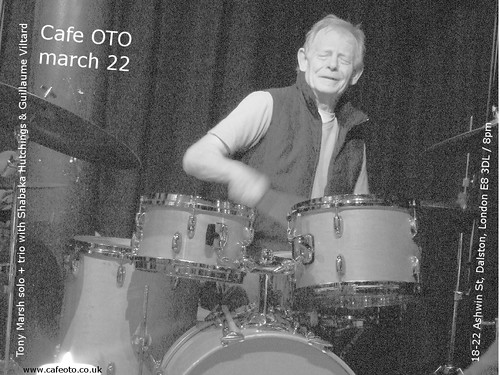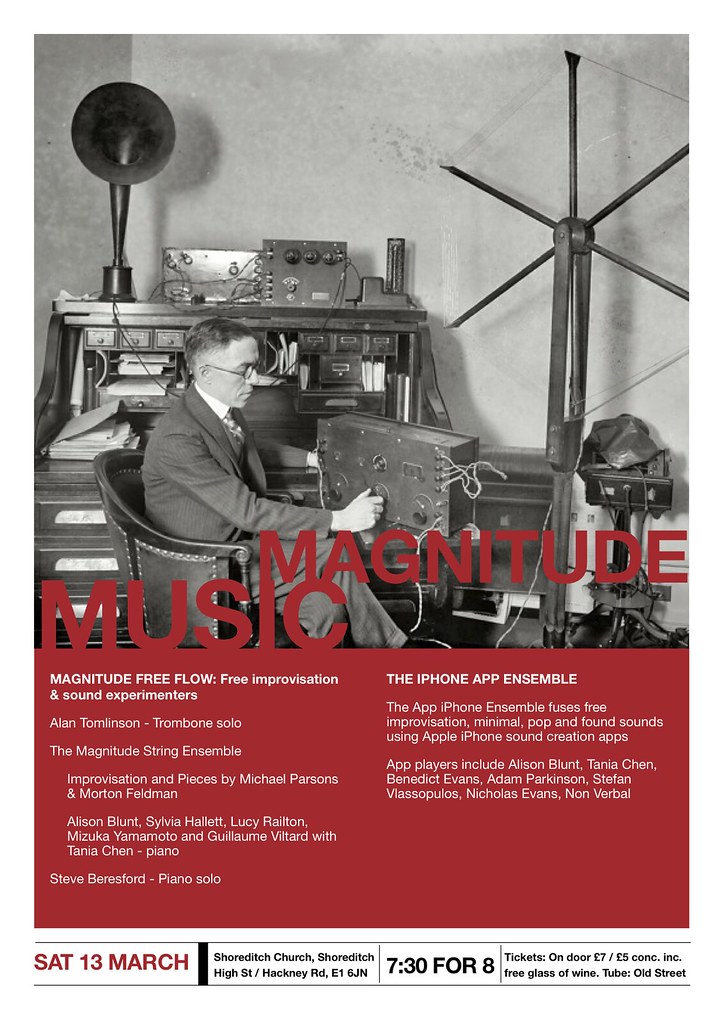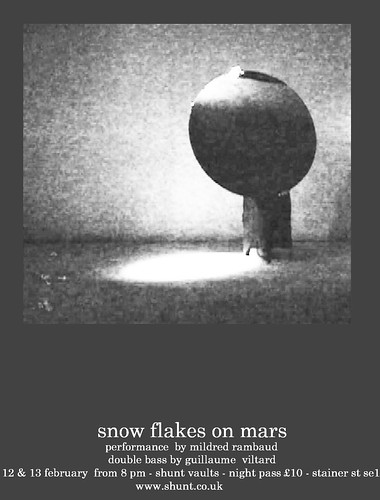
|
 |
news | with Tony Marsh on march 22
more about Tony Marsh |
|
news | Monday march 8
@ Cafe OTO Dalston 8pm |
|
ouïr | duo with Lol Coxhill
|
|
news | sat march 13
|
|
news | dance & music performance
friday 12 of february at 10 hr 30 and on saturday 13 of february at 8 hr 30 @ Shunt vaults , London Bridge / Entrance is through the door on Joiner Street SE1 |
|
news | STEVE BERESFORD’S BIRTHDAY
Christian Marclay - turntables |
|
news | feb’10 newsMonday 1st - Boat’ting With Lol Coxhill (soprano saxophone) & Steve Beresford (electronics) @ Bar&Co, ——————————————————– Friday 5 - “snowflakes on mars”, perfomance with dancer Mildred Rambaud @ Shunt , London Bridge 9pm / Entrance is through the door on Joiner Street SE1 also on friday 12 & saturday 13 ———————————————————- Sunday 7 - ——————————————————— Monday 15 - Romuald Wadych – guitar / Noam Embar – accordion Cafe OTO, —————————————————- Tuesday 16 @ the Vortex
Eddie Prevost – drums / Phillip Somervell – piano /Guillaume Viltard - double-bass Eddie Prévost is one of the founding innovators of the new improvisationary music that emerged in the 1960s. His own contribution spans the experimentalism implicit in the music of AMM – with its emphasis upon exploring sound sources – as well as experimental references to the world of jazz. This trio is drawn together through association with Prévost’s workshop. Not free-jazz, not ‘free-bop, not free-improvisation, the trio displays many of the tonal and poly-rhythmic characteristics of jazz, but there is a strong emphasis on exploring the nature of sound and on collective playing. |
|
lire | more about “Running Away”Il vient de loin, à petits pas, soulève la poussière du chemin et s’approche de nous, titubant et grotesque, les bras tendus en une supplique muette. Puis il gémit, s’assied sur une pierre et pleure. Le silence s’ensuit, lourd de questions ouvertes. De sourds grondements naissent de sa poitrine et, dès lors, il chante, une mélodie pervertie à la récurrence tourmentée. Que faire sinon attendre qu’il nous parle, demande sa route, un verre d’eau ou l’asile pour la nuit ? Mais, déjà, sa voix s’est affermie. Il nous fustigerait presque, déçu qu’on ne l’ait pas encore compris, qu’on n’ait pas entendu qu’il ne faisait que passer et que, de cris en soupirs, ce n’est pas à nous qu’il s’adresse, mais à cette montagne, là-bas, au pied de laquelle il a décidé de creuser un trou pour mieux s’y étendre et mourir. Il nous en racontera, pourtant, des histoires à n’en pas croire son propre entendement, des cordes disloquées qui sonnent mieux après qu’on les a humiliées, des meubles fendus en leur centre d’où s’échappent encore les fantômes d’un passé flamboyant, des souvenirs d’un temps où la musique obéissait à d’inamovibles règles et l’urgence d’une révolution qui, de répétitions en silences, déboulonna les certitudes les mieux affirmées. Quand il nous eut dépassé, lorsqu’il eut rejoint le lieu de sa quête, il s’arrêta, embrassa la terre et creusa longtemps, avec rage et acharnement, un trou assez grand qui puisse les accueillir, lui et son instrument. Et l’herbe repoussa, enrichie de cet engrais imprévu, épais, saturé de mémoire et d’imaginaire. La seule fois que je vis Guillaume Viltard, auprès du saxophoniste Jack Wright et de l’électroniciste Grundik Kasyansky, je n’eus d’oreilles que pour cette contrebasse grinçante qui arrachait le son à la terre même, comme si l’instrumentiste avait souhaité s’y enfoncer à jamais. Et c’est exactement ce que je ressens à l’écoute de ce solo capté en mai 2008 au Local et dans Et si l’ouvrage semble un peu cher à certaines bourses (30€, ce n’est rien, mais il faut les avoir…), on peut encore en télécharger gratuitement le contenu musical sur le site d’Un Rêve Nu Joel Pagier, Improjazz janv. 2010 ————————– J’espère que ça ne va pas faire trop de premières d’un coup : Running away est le premier disque du label « Un rêve nu ». C’est le premier disque (à ma connaissance) du contrebassiste Guillaume Viltard et enfin, pour moi, la première critique. Non ça ne m’est pas venu comme ça, c’est une proposition de R&C. Ça ne m’est pas réservé. Une critique faite par un musicien pratiquant le même instrument. Une bonne idée. Surement. Ça fait maintenant un moment que je tourne autour du disque et puis bon… C’est donc un commentaire de musicien, de contrebassiste. Ce disque est l’issue sonore et picturale d’une proposition du label à Guillaume Viltard, et ce que nous entendons est en quelque sorte un choix collectif, même si bien sur c’est Guillaume qui joue. Les morceaux, ou plutôt les moments choisis le sont par Guillaume Viltard, Heddy Boubaker et Nicolas Carrière qui s’est aussi occupé de tout le son (prises, mixage, mastering etc). Pour en finir avec les détails, qui n’en sont pas toujours, le disque a été enregistré en multi-microphonies. Ce qui nous est donné à écouter est un choix entre plusieurs prises simultanées d’endroits différents. Parfois on ne sait pas trop ce que c’est. C’est bon. C’est du son. C’est une oreille (une pensée) à l’affut de ce que des doigts (combien ?) ou un archet produisent, ou les deux, et nous invite à nous promener là dedans, dans le comment il les tord, comment il s’en amuse, s’en détourne, les abandonne. Et puis les reprend. Il y a des moments ou l’on est vraiment surpris de ce que sort cette bonne vieille contrebasse et c’est magique. La prise de son est très bonne. Par contre, je suis gêné par l’équilibre dans les prises extérieures entre les deux sources sonores, les sons ambiants et ce qui est joué. C’est bien sur très intéressant de se déplacer, de se baigner dans des sons dont on va s’imprégner pour notre jeu. A un moment on a vraiment une sorte d’agonie de vieux vaisseau (cachalot) dans la forêt qui est d’une étrangeté superbe. Parce que, je ne sais pas vous, mais quand j’écoute un disque ou un concert, je cherche toujours ce qui est à l’origine de ce que j’entends. Par ce qui est à l’origine, je veux dire pourquoi la ou les personnes font ces choix. Et je peux partir loin dans le comment, pourquoi… Vous l’aurez compris, je ne suis pas trop d’accord avec ceux qui disent que l’art n’a pas de message, n’est pas politique etc… Même si tout ça est à bien peser. Mais donc là en l’occurrence ce qui me gêne, c’est que j’ai l’impression que ce que j’entends, n’est pas ce que Guillaume entends (des résonances locales qui ne doivent pas aller jusqu’à ses oreilles ou bien moins, des bruits secs qui jaillissent dans le micro…). Et comme moi ce qui me passionne c’est son voyage, comment il le mène. Eh bien des fois ça me met comme une distance. Alors peut être que là on arrive à la question : « comment parler exactement du disque ? » Pour la réalisation de l’objet, très beau travail de mise en forme de la peintre Zéhavite Cohen, peintures différentes sur chaque disque et chacune des deux plaques de bois encadrant le C.D. Pour la musique s’agit il d’une vision du travail solo de Guillaume Viltard ou d’un disque solo ? J’ai envie de dire que ce n’est pas complètement un disque solo. C’est expliqué sur le site internet. Mais rien sur le disque sinon le lien vers le site internet. Il faudrait que cet aspect soit plus explicité sur le disque lui même. Sans gacher le travail de la plasticienne. Pas facile sans doute. Revue & Corrigée dec 09 |
|
lire | about “Running Away” (again)December 12, 2009 Guillaume Viltard’s solo release Running Away seems a fitting release to be writing about right now. It is a CD that perhaps a couple of years back I would never have given a chance, let alone found myself enjoying over a good number of listens. Why? well its a solo acoustic double bass album that, in some places is busy and talkative. Although there is plenty of invention and diversity in the playing here, I wouldn’t have given it a second chance. We all grow older and wiser sometime I guess. Viltard was born in the So how does it sound? Is it busy, gabby, talkative etc…? does it sound like it could have been released just as easily in 1985? The answer is both yes and no to all of these questions. Do any of them really matter though? No, probably not. There are eight tracks on Running Away, and each has its own character. Six of the pieces are named Local 1-6, and the last two, named Bouconne 1 and 2 were recorded outside in a forest at Local 5 might be my favourite of the indoor (studio?) recordings. It has a distant, wistful feel to it as it begins, relaxing the listener, putting an arm around you before slowly complicating things, adding intricate detail and fraught, constant, almost overpoweringly urgent bowed sounds. Digging your ears deep into this piece, closely following the music through its endless twists and turns is a troubling, difficult experience, but a powerful one all the same.Confusingly, the last of the Local pieces, number six, begins, and runs for just a hanful of seconds before the CD player clicks over to the next track, the first of the forest recordings, but with the timer counting down from minus seven and a bit minutes. Certainly, on this beautiful little track birdsong can be heard in the background, but it isn’t completely clear if the recording actually takes place in the forest, or if a recording made there is layered behind the studio capture. As the forest sounds start to take hold in this piece, so Viltard’s playing becomes quieter, and much less busy, as if responding directly tot the gentle calm of these surroundings, or at the very least a recording of them. The downloadable tracks all seem to last different lengths to the ones on the CD as well (Its a “proper” CD not a CDr as well, so this isn’t a case of a bad burn) but again this doesn’t matter. This music probably doesn’t need any great analysis, its beauty comes through the powerful interaction between human and instrument, following a great tradition, but losing none of its power through this. The Bouconne forest tracks (track?) are just lovely, the way the bass seems to duet with the streams of twittering high pitched birds and occasional cuckoo bellows is a real joy.Running Away is great, gripping, exciting stuff that I can listen to over and over again. It certainly isn’t all blood and thunder stuff, the music is varied throughout, but always deeply sensual. Its also the second straight-up solo double bass album I have spent a lot of time with this year after John Edwards’ excellent Volume. I must be getting old |
|
news | probably the last of the year (for me)quartet with I-Chin Li (piano) Chien-Chun Li (voc) Ryo Ikeshiro (gt & laptop)
|
|








